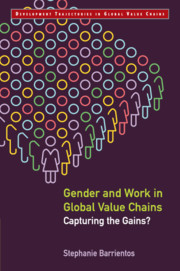Book contents
- Frontmatter
- Dedication
- Contents
- List of Tables
- List of Figures
- List of Abbreviations
- Preface
- 1 Introduction
- 2 Retail Shift and Global Sourcing
- 3 Gender Patterns of Work in Global Retail Value Chains
- 4 Global (re)Production Networks Analysis
- 5 Smallholder (dis)Articulations: The Cocoa–Chocolate Value Chain
- 6 Mixed Outcomes: Downgrading and Upgrading in African Horticulture
- 7 Contested Terrain: The Limits of Social Compliance in Asian Apparel
- 8 Upgrading Strategies: Innovation, Skills and Rights
- 9 Governance Challenges: Promoting Gender-Equitable Value Chains
- 10 Concluding Reflections: Future of Work
- References
- Index
4 - Global (re)Production Networks Analysis
Published online by Cambridge University Press: 26 April 2019
- Frontmatter
- Dedication
- Contents
- List of Tables
- List of Figures
- List of Abbreviations
- Preface
- 1 Introduction
- 2 Retail Shift and Global Sourcing
- 3 Gender Patterns of Work in Global Retail Value Chains
- 4 Global (re)Production Networks Analysis
- 5 Smallholder (dis)Articulations: The Cocoa–Chocolate Value Chain
- 6 Mixed Outcomes: Downgrading and Upgrading in African Horticulture
- 7 Contested Terrain: The Limits of Social Compliance in Asian Apparel
- 8 Upgrading Strategies: Innovation, Skills and Rights
- 9 Governance Challenges: Promoting Gender-Equitable Value Chains
- 10 Concluding Reflections: Future of Work
- References
- Index
Summary
Introduction
The transformation of global retail that has taken place over the past three decades is associated with changing gendered patterns of work. The previous two chapters explored this transformation empirically, fleshing out the commercial dynamics of global retailers and their supply networks as well as the role fragmented work plays in facilitating global value chains. Global retail expansion has fed on and fuelled the changing role of women who constitute the majority of their customers and increasingly juggle paid work with household responsibilities. Global sourcing provides the channel through which a wide range of goods is available at reasonably affordable prices on a JIT basis. Hundreds of millions of workers, a significant proportion female, are now deployed in labour-intensive global production, mainly in emerging and low-income countries.
This chapter focuses on the analytical dimension of the global retail transformation and associated changing gender patterns of work. The rise of global retail value chains challenges the underlying assumptions of much conventional analysis of markets, labour and gender. Prevailing analyses of production and trade have largely assumed that exchange takes place through markets within and between countries. Yet in global value chains, lead firms govern their supply chains without ownership, and coordinate production and trade across suppliers spanning multiple countries.
Prevailing analysis of labour has largely assumed the predominance of an employer–employee relationship regulated within national labour markets. Yet in retail value chains, lead firms that operate outside the national legal jurisdiction of suppliers and their workers can also influence supplier employment relations. Prevailing analysis of gender tends to assume a division of labour between the productive sphere of paid work and the reproductive sphere of unpaid work. Yet in retail value chains, the commercialization of household consumer goods and the feminization of employment are blurring the boundaries between productive and reproductive labour, as well as paid and unpaid work.
This chapter analytically addresses the core questions of this book: How are global retail value chains shaping gender patterns of work, and what are the gendered outcomes for workers? I draw on a combination of analytical approaches to investigate this question.
- Type
- Chapter
- Information
- Gender and Work in Global Value ChainsCapturing the Gains?, pp. 79 - 103Publisher: Cambridge University PressPrint publication year: 2019

